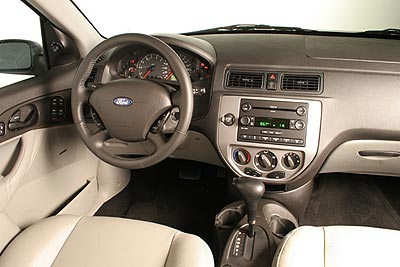Recent Articles
Popular Makes
Body Types
2006 Ford Focus ZX5 Review
Going green doesn't mean going hybrid
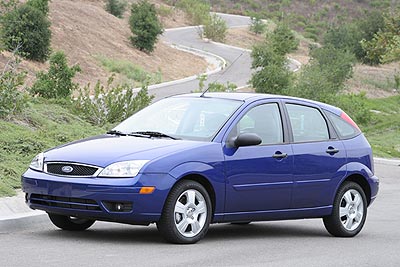
Ford Focus – Driving Impressions: What's the point of doing a story about the Ford Focus, a car that is seven years old and sitting, unloved, in the shadows of hot new models like the Honda Fit, Nissan Versa, and Toyota Yaris? We think it's an overlooked gem, a fun, functional, and frugal car, and an undeniable bargain that meets the needs of the times. Plus, like popular hybrid models that cost thousands more, the Focus gets good gas mileage by the EPA's standards, carries a Partial Zero Emissions Vehicle (PZEV) rating in California and New England, posts decent crashworthiness and reliability scores, and deserves your consideration. That's why. And if you look in this Sunday's newspaper, you'll find that dealers are blowing these cars out the door for thousands off the sticker price. Good thing, considering our fully loaded 2006 Ford Focus ZX5 SES test car carried a sticker price of $20,000, including the $545 destination charge. But our vehicle was the top-line trim level with lots of goodies; most Ford Focuses sell for well below that figure. Ford offers the Focus in a variety of styles and trim levels. Choose between a three- or five-door hatchback (ZX3 or ZX5), a sedan (ZX4), or a station wagon (ZXW). Trim levels for all styles are S, SE, and SES, with a sporty ST model reserved for the sedan. The least expensive S is pretty basic, including a manual transmission, 15-inch wheels and tires, and a stereo with a CD/MP3 player. The SE is the most popular model, equipped with power windows, power door locks, power mirrors, remote keyless entry, air conditioning, and a center arm rest that improved comfort levels. Stepping up to the SES nets 16-inch alloy wheels, fog lights, cruise control, a tilt and telescopic steering wheel, a tachometer, and body-color exterior trim. The performance-oriented Focus ST gets hardware upgrades to make it go faster and handle better, minor styling differences, heated outside mirrors, sport seats, and upgraded interior décor. Major options on the various Ford Focus models include an automatic transmission, side-impact airbags for the front seats, a power sunroof, traction control, and an upgraded audio system with a six-disc in-dash CD changer. Under the hood of the S, SE, and SES models is a 2.0-liter four-cylinder engine delivering 136 horsepower at 6,000 rpm and 133 lb.-ft. of torque at 4,500 rpm to the front wheels. In California and New England, the engine is rated PZEV, which means exhaust emissions are cleaner than some hybrid cars. The EPA says this engine will deliver 26 mpg in the city and 34 mpg on the highway with the manual transmission (32 mpg highway with the optional automatic transmission), which isn't as good as most hybrids but then, the Focus is less expensive to buy in the first place. A four-wheel-independent suspension, rack-and-pinion steering, front disc/rear drum brakes, and 15-inch wheels wearing 195/60 all-season tires (16s shod with 205/50 Pirelli P6s on the SES) complete the standard Focus picture. For added fun, try the Focus ST. Fuel economy is penalized by the Mazda-sourced 2.3-liter four-cylinder at 22 city and 31 highway, and you'll need to know how to drive a stick since there's no option for an automatic on the ST model, but the trade-off is 151 horsepower at 5,750 rpm and 154 lb.-ft. of torque at 4,250 rpm. This engine does not meet PZEV requirements, frustrating since Ford first offered a 2.3-liter PZEV engine in the Focus way back in 2003, and it made more power than today's ST engine. The ST's suspension is based on what used to be under the SVT hot-hatch of a few years ago, there's a four-wheel-disc antilock braking system, and it gets unique alloy wheels. We grabbed a Sonic Blue 2006 Ford Focus ZX5 SES for this evaluation, carrying a base price of $17,030 including the $545 destination charge. It came with an automatic transmission ($815), a Weather Package ($175 – heated seats and side mirrors), a Safety Package ($350 – ABS and side-impact airbags), traction control ($115), a perimeter alarm ($125), an Audiophile stereo with a six-disc CD changer and Sony speakers ($695), and leather seats ($695). We could have lived without most of this extra stuff. At the end of our week-long test, it was clear that the European-designed and engineered Ford Focus has aged gracefully, but that the aging process is rapidly gaining speed. The car is still fun to drive and functional, though not as frugal as we anticipated. Also, despite the high price tag on our test sample, this car is still a bargain if you choose the popular SE trim level, definitely worth a look when the local Ford dealer is offering big discounts or low-interest financing. Clearly, however, given concerns about fuel economy, safety, and the environment, it's time for Ford to refocus on the Focus.
Performance
Under the hood of the 2006 Ford Focus is a 2.0-liter four-cylinder engine making 130 horsepower. Our test car transferred this power to the front wheels through a four-speed automatic transmission. Gearing makes the Focus feel lively in traffic, but when passing on the highway the Focus makes lots of noise but little extra forward motion. The car can, however, cruise all day at 80 mph with little effort, and the automatic does a great job of holding third gear for hill climbing. Fuel economy with this powertrain was disappointing at just 23.3 mpg, substantially less than its 26/32 EPA estimate. The main thing to love about the engine is that in some regions of the country it's rated as a Partial Zero Emission Vehicle (PZEV), which means it burns as cleanly as a hybrid.
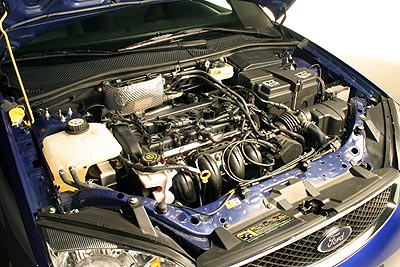
Handling
Engineered in Europe and brought to America to replace the Escort in 2000, the Ford Focus is a deft handler with excellent grip provided by meaty P205/50 Pirelli P6 tires mounted to handsome 16-inch alloy wheels (SES and ST models). The body rolls in turns, and the ride quality is a bit stiff, but otherwise the Focus is actually fun to drive. Pitch it into a corner and once the body keels over the Pirellis dig in, squealing just a little bit but providing impressive stick. The brake pedal feels good underfoot and the four-wheel-disc ABS scrubs speed quickly, while the steering offers crisp response and better road feel than is expected in this class. The Focus is a breeze to parallel park, too, with a tight turning radius and corners that are relatively easy to judge.
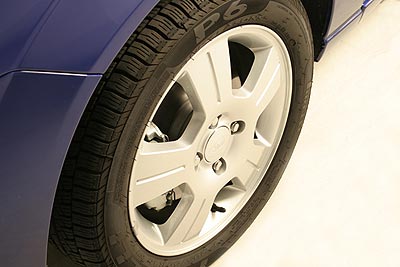
Visibility
Thanks to a tall seating position, a large windshield, a dashboard mounted low and out of the way, and thin front roof pillars, the Ford Focus offers outstanding forward visibility. We easily carved through thick traffic in our test car, mainly because it was so easy to see the path of least resistance through the morass of brake lights. Rear visibility is good too, because the Focus doesn't come with rear headrests. Of course, that means whiplash for any rear seat occupants in a wreck, but at least the driver will be able to see the wreck coming thanks to a clear view through the back window. The rear roof pillars are somewhat thick, but small quarter windows help nicely when reversing from slanted parking spaces. If there is a visibility nit to pick, it's with the thin, teardrop-shaped side mirrors, which take some getting used to.
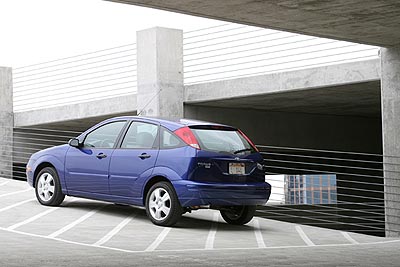
Fun to Drive
Even with the automatic transmission, the Ford Focus is fun to drive – especially in SES trim with the larger 16-inch wheels and Pirelli tires or the ST performance model. The steering, braking, and handling are excellent for the compact car class, and the standard engine is strong enough to keep up in traffic and cruise at 80 mph on the highway. The Focus is old, having debuted in Europe in the late 1990s, but it's still got that tight, crisp, responsive feel that every car from the old country possesses. If you're looking for a commuter car that's easy on the environment but is still entertaining to drive, the Ford Focus is worthy of a test drive.
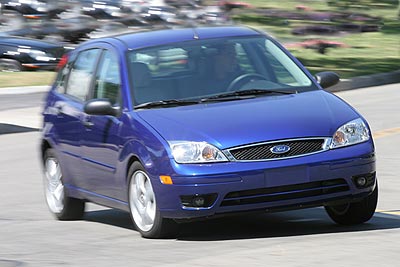
Front Comfort
Though they sit tall and the driver's seat is height adjustable, I've never gotten completely comfortable in a Ford Focus. Since the car's first year on the market, I've complained about the seats, even though for longer road trips they seem to produce enough support to keep from exhausting the driver after hundreds of miles behind the wheel. My issue is that there isn't a separate cushion tilt feature that would provide added thigh support. I'd take that, or the ability to move the seat further to the rear for added leg room. I also take issue with the hard plastic upper door sill, which is unfriendly to elbows. Otherwise, I have no issues with front seat comfort. It's easy to get into and out of a Focus, thanks in part to a seat slide lever perfectly positioned for taller people to move the seat back after a shorter driver has been driving, and the SES models have a nicely sized tilt-and-telescopic steering wheel with a thick rim that is good to hold. The center armrest is also helpful, and is slightly padded for comfort.
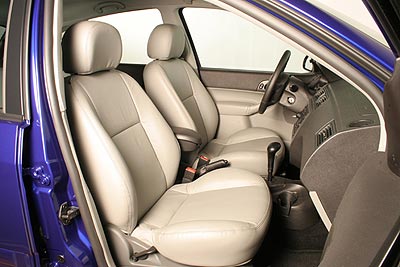
Rear Comfort
The Ford Focus benefits from a tall rear seat cushion that provides excellent thigh support, which makes the tight leg room less of an issue than it otherwise might be. Foot space is good, too, but four tall adults are a tight squeeze. Entry and exit are also a bit difficult, though that tall rear bench helps here, too, due to its high H-point. Note that the Focus doesn't have rear headrests, which means a greater likelihood for whiplash injury in a rear impact.
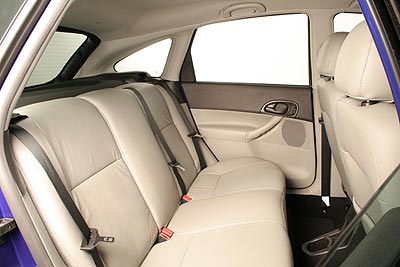
Interior Noise
Like most small cars, the Ford Focus is loud inside. Under acceleration, the engine drones, and there's plenty of road and wind roar at speed. What we didn't hear in our test car was rattles, squeaks, or excessive noise from the suspension. And, if you've popped for the optional Audiophile stereo with six-disc CD changer, there's plenty of rich sound to help drown out the engine, tire, and wind noise.

Loading Cargo
When it comes to small cars, few match the utility afforded by a five-door configuration. We used our Ford Focus ZX5 test car for a day trip to the beach, and it easily swallowed a tall beach umbrella, blankets, chairs, a cooler, backpacks, and one of the great inventions of modern history – Match Light barbecue charcoal – with the rear seats folded down. The Focus has a wide hatch opening and a low liftover height, making it even easier to stuff the car full of stuff. There is a problem with the design, however. To fold the rear seatbacks flat, the bottom cushion must be flipped up. The seatbacks are a 60/40 split design, the bottom cushion is not. This design precludes expanding the cargo space with a flat load floor while carrying a third passenger in comfort – an arrangement we needed after that day at the beach.
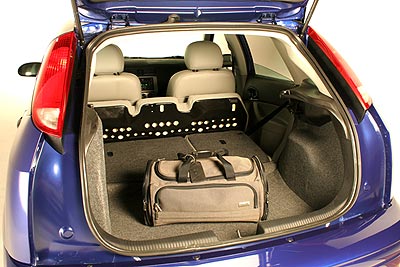
Build Quality
With large panel gaps inside and out, the Ford Focus shows its age. This is an old design, and has trouble competing in terms of perception of quality. Adding to that perception were a hood that didn't sit flush with the fenders and appeared to be crooked, unimpressive front fascia fit, and minor door fit issues. Inside, the door covering the clever CD storage slot was warped and the lower left dash panel displayed sloppy installation, but generally the cabin was tight and solid, especially the roof pillar covers which are traditionally a weak spot on many vehicles.
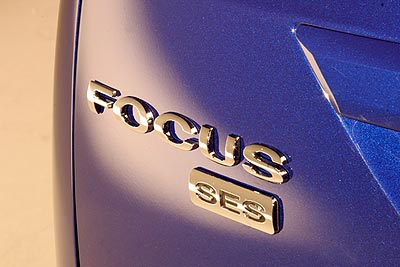
Materials Quality
Frequently, cheap cars are made of cheap materials, so the hard plastic surfaces inside the Ford Focus aren't surprising. Trouble is, models like the Honda Fit and Nissan Versa are proving that cheap cars don't necessarily mean cheap materials, which puts the Ford Focus at a competitive disadvantage. We're not sure we see the point of spending extra for leather in a set of budget wheels, but the hides in our test car were decent enough with a low-gloss sheen and subdued grain. At least the plastic on the dashboard and door panels displayed a matte finish and a pleasing pattern. Also to its credit, many of the Focus's controls have a refined, substantial feel – such as the radio buttons and the climate knobs – but the overhead console is the epitome of cost cutting, and should be tossed into a trash bin where it belongs.
